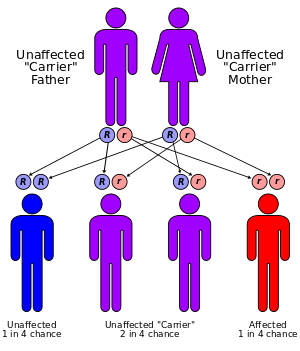Abderhalden–Kaufmann–Lignac syndrome
| Abderhalden-Kaufmann-Lignac syndrome | |
|---|---|
| Classification and external resources | |
| ICD-9-CM | 270.0 |

Abderhalden-Kaufmann-Lignac syndrome has an autosomal recessive pattern of inheritance.
Abderhalden–Kaufmann–Lignac syndrome (AKL syndrome), also called Abderhalden-Lignac-Kaufmann disease or nephropathic cystinosis, is an autosomal recessive renal disorder of childhood comprising cystinosis and renal rickets.
Eponym
It is named for Emil Abderhalden, Eduard Kaufmann and George Lignac.[1][2]
Presentation
Affected children are developmentally delayed with dwarfism, rickets and osteoporosis. Renal tubular disease is usually present causing aminoaciduria, glycosuria and hypokalemia.
Cysteine deposition is most evident in the conjunctiva and cornea.
See also
References
- ↑ B.G. Firkin & J.A.Whitworth (1987). Dictionary of Medical Eponyms. Parthenon Publishing. ISBN 1-85070-333-7
- ↑ Who Named It?
| ||||||||||||||||||||||||||||||||||||||||||||||||||||||||||||||||||||||||||||||
This article is issued from Wikipedia - version of the Wednesday, February 03, 2016. The text is available under the Creative Commons Attribution/Share Alike but additional terms may apply for the media files.